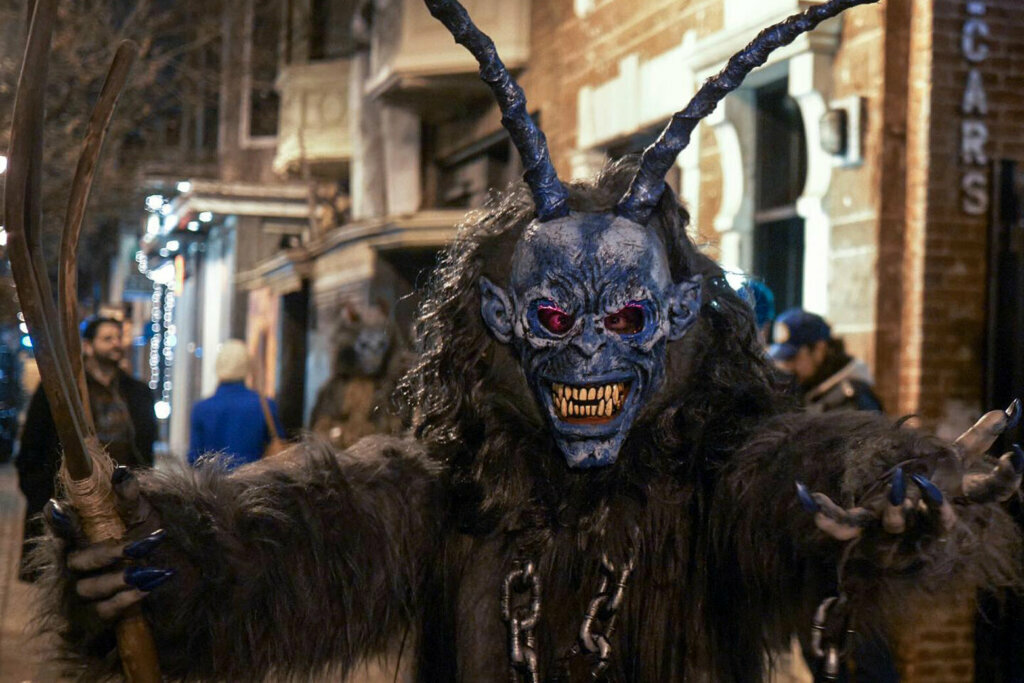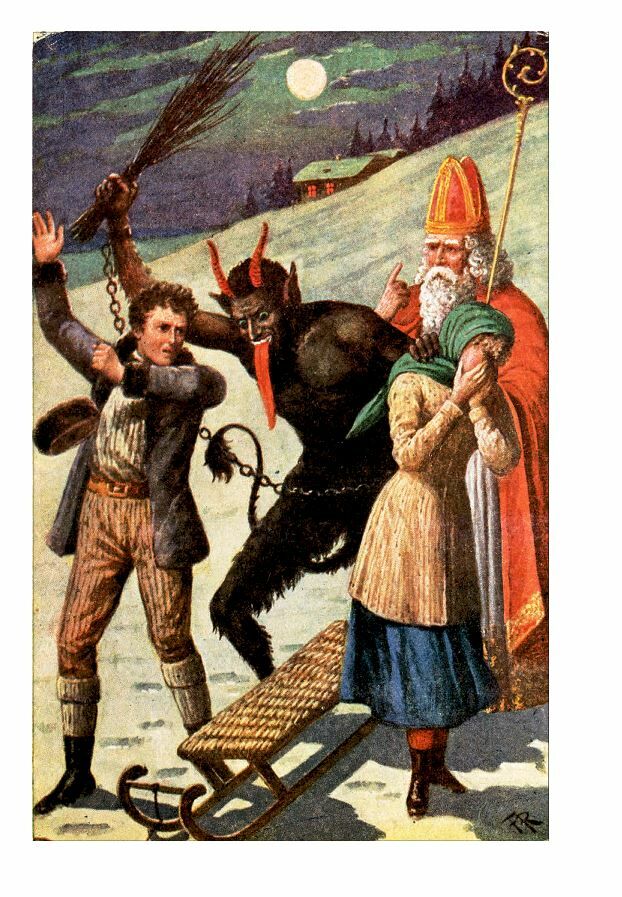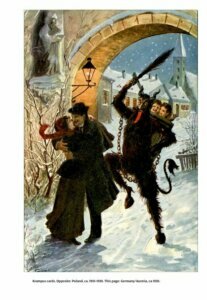
He sees you when you’re sleeping
He knows when you’re awake
He knows if you’ve been bad or good
So be good for goodness sake
Santa Claus ain’t the only one coming to town. And his dark half will do worse than put coal in your stocking if you haven’t been good this Christmas.
With the tradition of St. Nick comes Krampus, a horned half-goat, half-demon who, instead of giving gifts, punishes children during the Christmas season.
According to James Deutsch, curator of Folklife and Popular Culture with the Smithsonian, Krampus wasn’t, and arguably still isn’t, very well known in the U.S. until recently.
“It was more of a very local phenomenon in southern Germany and in Austria among Catholic communities, primarily,” Deutsch told WTOP.
Krampus’ ultimate purpose was to make sure kids behaved.

“This was a way for the authorities to not really enforce obedience among young children, but just to promote the idea that, at the end of the year, if you want your gifts from St. Nicholas, then you should be good, and if you’re not good, then you will be taken by this other figure,” Deutsch said.
Different regions in Europe developed their own Krampus variants, according to Deutsch, “but always following a general pattern: Something that is scary, because you want to scare the children in your community into doing … the right thing or just always holding this threat. ‘If you’re not good, then you will be taken by Krampus.'”
In most depictions, Krampus has a basket on his back in which he shoves the children who have not been good. Then they’re taken to “a place you do not want to go,” Deutsch said.
“Like a lot of folklore, [Krampus is] rooted in old, old traditions that we maintain, even without knowing the legacies of the things.”
Deutsch emphasized that how old the lore is, or where it came from, isn’t important.
“What is important is that you or your community has a tradition,” Deutsch said. “We maintain these traditions because it gives us a certain sense of belonging to a group and a community. And so the same is true for Halloween costumes or the winter solstice traditions, which have taken on different forms in different places, depending on the group.”

And, of course, Krampus is a threat. A horned goat-demon does not literally come to take children away. It’s roughly equivalent to the threat of getting coal instead of a present — though the hypothetical punishment is a bit more severe.
As for why the idea of Krampus is so appealing, Deutsch likened it to the fascination people have with Darth Vader or Freddy Krueger.
“Darth Vader is the most compelling character and it’s because we are drawn to the dark side — but as long as we can keep it at it a distance,” Deutsch said.
Krampus’ lack of popularity in the U.S. can definitely be tied to a lack of commercialization. Aside from the wonderful 2015 film directed by Michael Dougherty, you generally won’t see Krampus’ visage on anything at a major store.
“Coca Cola is not going to commercialize a character who looks the way Krampus does,” Deutsch said. “Coca Cola is about selling a product and you want positive associations with your product. … [not] a character that is evil.”
“McDonald’s is not going to have Hannibal Lecter do a testimonial.”
Krampus does have some positive associations. Namely, Krampusnacht DC, which has been organizing charity walks through the District since 2013. (The pandemic forced them to cancel the 2020 parade.)
“We’re pretty creative bunch,” Rick Dostal, marketing and PR director for Krampusnacht DC, told WTOP. “It was an awesome group of people and an awesome idea and the cause behind it just brought everyone together and everyone just fell in love with it.”
“Krampusnacht has three phases to it,” Dostal said. “We start out as a very family friendly, kid-oriented scene, where the kids get face paint and crafts and stuff like that. They come and see Santa, then there’s Krampus.”
During the second part of Krampusnacht, costumed revelers “take it on the road. And the police are fully on board, all the businesses are there, and everyone, it would really become an anticipated event for the holiday season on H Street,” Dostal said. “We just have a lot of fun with that.”
You can see Krampuses (Krampii?) dancing around and playfully teasing people.
After the walk, it becomes a more adult event for those 21 and over, including hot cider, a cash bar, DJ and dancing.
“We rock out,” Dostal said. “So there’s a little bit of everything for everyone. If you want some adult play time, we’ve got that, if you want fun with kids and the family, we’ve got that. So it’s a broad spectrum. I think that’s why it really appeals to a lot of people.”
Funds raised from Krampusnacht DC go to help displaced children in the Washington area and at-risk orphans in the system. Dostal says they’re currently helping over 400 kids.
“It’s a really beautiful thing,” Dostal said. “Normally there’s a banquet for the kids.”

At the banquet, Mr. and Mrs. Claus show up.
“And they deliver gifts specifically to the kids, directly to the kids — stuff that they want,” Dostal said. “But it doesn’t just end with the holidays. They also take care of them for their birthdays, same deal. They get a gift specifically for them that they want. And then we make sure that they have proper school supplies and clothing and what they need throughout the school year. And then if money is available, I think so far it has been, once you start to age out of the system, we make sure you get a laptop.”
For the people behind Krampusnacht DC, it’s not just a feel-good story for the holidays.
“It’s truly a genuine thing,” Dostal said. “Because there’s these kids, and it’s not just a gift, it’s also knowing that there’s somebody in the world that’s on their side. It’s doing something really, really good for them, that they matter, that someone cares.
“And that’s actually the beautiful gift that we’re giving.”
Even though the 2020 parade was canceled, the funds from 2019’s event will support the group’s efforts this year. But 2021 could be in limbo because there was no 2020 gathering.
People can help Krampusnacht DC and the people behind it by supporting their sponsors, and by supporting their performers.
So be good, for goodness’ sake.







